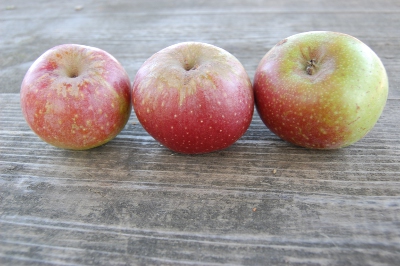︎︎︎ MELA ROSA
IN PIETRA

E’ stata ritrovata nella zona di Gualdo Tadino (PG), e probabilmente viene dalle vicine Marche, dove analoga varietà viene chiamata mela Sassa, alludendo alla durezza del frutto. Viene coltivata ancora in piante singole nella zona. E’ una ottima varietà ad elevata rusticità e resistente ai più comuni parassiti. Adatta alla coltivazione di montagna ed alta collina. La pianta è mediamente vigorosa, a chioma aperta; produce in maniera costante e fiorisce in epoca tardiva. E’ molto rustica. Poco sensibile alla ticchiolatura, poco sensibile alla Carpocapsa Il frutto è medio grande (gr. 140-165), di forma rotondeggiante, simmetrico e schiacciato ai poli. Il peduncolo è medio lungo inserito in cavità, mediamente profonda e aperta, spesso rugginosa. La cavità calicina è semiaperta. La buccia molto spessa è di colore verde con macchie diffuse rosso vinoso e numerose lenticelle, bianche e molto evidenti. La polpa è bianca, acidula, soda, a tessitura molto fine e aromatica, non molto succosa ma di buona qualità. Questa mela viene raccolta tradizionalmente in novembre dopo S. Martino e si conserva egregiamente in fruttaio fino alla primavera successiva. Si può cominciare a consumare a gennaio. Certamente da consumo fresco per la sua capacità di conservazione, è anche ottima mela da cottura, e da composta che si ottiene facendo fondere lo zucchero (mezzo chilo per ogni litro d’acqua, per ogni chilo di frutta) e quando è fuso, si gettano dentro le mele tagliate in quattro e si fanno bollire per circa venti minuti. Si mette il tutto nei vasi con aromi, e si sterilizza a bagnomaria.
The mother plant was recovered in the area of Gualdo Tadino (Perugia) and it may have originated from the neighboring Marche, where an analogous variety is called mela sassa (stone apple), referring to the hardness of the fruit. This is an excellent variety, still cultivated in individual specimens in the area. It is very hardy and resistant to the most common pests. It is suited for cultivation in mountainous areas and it is very attractive for its good storage qualities. The tree is moderately vigorous, with open crown; it crops regularly and blooms late in the season. It is very hardy. The fruit is medium-large size, being round and symmetrical in shape and flattened at both ends. The stem is medium-long and inserted in a moderately deep and wide cavity. The calyx is open. The skin is very thick, green jn colour and mottled wine-red all over and with numerous white and marked lenticels. The flesh is white, slightly tart, firm, with a very fine and aromatic texture. It is not too juicy but of very good quality. This apple is traditionally harvested in November after the San Martino holiday and stores very well in the fruit-house until the following spring. It can be eaten from January on. It is certainly suited for raw eating given its storing capacity. It is also excellent for cooking and for making compotes. For the latter, dissolve sugar in water (half a kilogram per liter of water and each kilogram of fruit) and heat. When it is completely dissolved, throw in the apples sliced in four wedges. Let them boil for about twenty minutes. Place everything with the addition of spices and it is sterilized in a water bath.